Mineral Reaction Kinetics during Aciding of the Gaoyuzhuang Carbonate Geothermal Reservoir in the Xiong’an New Area, Northern China
Abstract
1. Introduction
2. Geological Conditions
3. Methodology
3.1. Materials
3.2. Experimental Strategy
3.2.1. Rock Debris Dissolution Ratio
3.2.2. Reactor Experiment
3.2.3. Ion Concentration Analysis
3.3. Mineral Reaction Kinetic Model
3.3.1. Mineral Reaction Rate
3.3.2. Mineral Reaction Surface Area
3.3.3. Thermodynamics Database
3.3.4. Model Building
4. Results and Discussion
4.1. Rock Debris Dissolution Ratio
4.2. Reactor Experiments
4.2.1. Mineral Dissolution and Ion Concentration Changes
4.2.2. Effect of Temperature on the Dissolution Rate
4.3. Mineral Reaction Kinetic Parameters
5. Conclusions
- (1)
- The main lithology of the Gaoyuzhuang Formation in the Xiong’an New Area is dolomite, that is, dolomite is the main constituent mineral, followed by quartz and clay minerals.
- (2)
- Hydrochloric acid can produce a good dissolution effect on the Gaoyuzhuang Formation. The average dissolution ratio of 15 wt.% HCl on the rock debris reached 84.1%, so 15 wt.% HCl can be used as the main acid solution for acidizing.
- (3)
- Under the action of hydrochloric acid, the dolomite, calcite and illite were dissolved, generating a large amount of . The dissolution of the potassium feldspar and plagioclase was not obvious.
- (4)
- The temperature had an obvious effect on the dissolution rates of the minerals. As the temperature increased from 40 °C to 100 °C, the time required for core dissolution to occur decreased from 20 min to 5 min.
- (5)
- The mineral reaction kinetic model based on transition state theory describes the mineral dissolution process well. Under the action of hydrochloric acid (acidic reaction mechanism), the reaction rate constants of dolomite, calcite and illite reached 2.4 × 10−4, 5.3 × 10−1 and 9.5 × 10−2 , respectively.
Author Contributions
Funding
Acknowledgments
Conflicts of Interest
References
- Chen, M. Geothermics of North China; Science Press: Beijing, China, 1988. [Google Scholar]
- Wang, G.; Zhang, W.; Lin, W.; Liu, F.; Zhu, X.; Liu, Y.; Li, J. Research on formation mode and development potential of geothermal resources in Beijing-Tianjin-Hebei region. Geol. China 2017, 44, 1074–1085. [Google Scholar]
- Pang, Z.; Kong, Y.; Pang, J.; Hu, S.; Wang, J. Geothermal Resources and Development in Xiongan New Area. Bull. Chin. Acad. Sci. 2017, 32, 1224–1230. [Google Scholar]
- Wang, Z.; Zhang, C.; Jiang, G.; Hu, J.; Tang, X.; Hu, S. Present-day geothermal field of Xiongan New Area and its heat source mechanism. Chin. J. Geophys. 2019, 62, 4313–4322. [Google Scholar] [CrossRef]
- Guo, S.; Zhu, C.; Qiu, N.; Tang, B.; Cui, Y.; Zhang, J.; Zhao, Y. Present Geothermal Characteristics and Influencing Factors in the Xiong’an New Area, North China. Energies 2019, 12, 3884. [Google Scholar] [CrossRef]
- Wang, G.; Li, J.; Wu, A.; Zhang, W.; Hu, Q. A study of the thermal storage characteristics of Gaoyuzhuang Formation, a new layer system of thermal reservoir in Rongcheng Uplift area, Hebei Province. Acta Geosci. Sin. 2018, 39, 533–541. [Google Scholar]
- Lin, W.; Wang, G.; Gan, H.; Zhang, S.; Zhao, Z.; Yue, G.; Long, X. Heat Source Model for Enhanced Geothermal Systems (EGS) under Different Geological Conditions in China. Gondwana Res. 2022, in press. [Google Scholar] [CrossRef]
- Ma, F.; Wang, G.; Zhang, W.; Zhu, X.; Zhang, H.; Sun, Z. Influence Mechanism of Ancient Buried Hill Geothermal Development on Land Subsidence. Geol. China 2021, 48, 40–51. [Google Scholar]
- Yue, G.; Wang, G.; Ma, F.; Zhu, X.; Zhang, H. Evaluation of fault slip probability of geothermal large-scale development:A case study of deep karst geothermal reservoir in Xiong’an New Area. Geol. China 2021, 48, 1382–1391. [Google Scholar]
- Wang, S.; Liu, J.; Sun, Y.; Liu, S.; Gao, X.; Sun, C.; Li, H. Study on the Geothermal Production and Reinjection Mode in Xiong County. J. Groundw. Sci. Eng. 2018, 6, 178–186. [Google Scholar]
- Yue, G.; Wang, G.; Ma, F.; Zhu, X.; Zhang, H.; Zhou, J.; Na, J. Fracture Characteristics and Reservoir Inhomogeneity Prediction of the Gaoyuzhuang Formation in the Xiong’an New Area: Insights from a 3D Discrete Fracture Network Model. Front. Earth Sci. 2022, 10, 1–12. [Google Scholar] [CrossRef]
- Ke, B.; Zhao, L.; Wen, Z. Application of shot hole and acid fracturing technology in geothermal well washing. Explor. Eng. 2007, 08, 17–19. [Google Scholar]
- Wang, L.; Li, M.; Cheng, W.; Jiang, G. Application of acidifying & fracturing technology to carbonate rock reservoir. Hydrogeol. Eng. Geol. 2010, 37, 128–132. [Google Scholar] [CrossRef]
- Wang, P.; Zong, Z.; Li, Z.; Xu, Y.; Tian, G. Application analysis on acidification and crushing technology for increasing geothermal yield. Explor. Eng. 2011, 38, 30–33. [Google Scholar]
- Järvinen, L.; Leiro, J.; Bjondahl, F.; Carletti, C.; Lundin, T.; Gunnelius, K.; Smått, J.-H.; Eklund, O. Characterisation of Dolomites before and after Reactivity Measurement with HCl Solution: Characterisation of Dolomites. Surf. Interface Anal. 2015, 47, 284–294. [Google Scholar] [CrossRef]
- Alkattan, M.; Oelkers, E.H.; Dandurand, J.-L.; Schott, J. An Experimental Study of Calcite and Limestone Dissolution Rates as a Function of PH from Y1 to 3 and Temperature from 25 to 808C. Chem. Geol. 1998, 16, 199–214. [Google Scholar] [CrossRef]
- Fredd, C.N.; Scott Fogler, H. The Kinetics of Calcite Dissolution in Acetic Acid Solutions. Chem. Eng. Sci. 1998, 53, 3863–3874. [Google Scholar] [CrossRef]
- Hoşten, Ç.; Gülsün, M. Reactivity of Limestones from Different Sources in Turkey. Miner. Eng. 2004, 17, 97–99. [Google Scholar] [CrossRef]
- Gautelier, M.; Oelkers, E.H.; Schott, J. An Experimental Study of Dolomite Dissolution Rates as a Function of PH from Y0.5 to 5 and Temperature from 25 to 808C. Chem. Geol. 1999, 157, 13–26. [Google Scholar] [CrossRef]
- Oelkers, E.H.; Schott, J. Experimental Study of Kyanite Dissolution Rates as a Function of Chemical Affinity and Solution Composition. Geochim. Cosmochim. Acta 1999, 63, 785–797. [Google Scholar] [CrossRef]
- Yoo, H.; Kim, Y.; Lee, W.; Lee, J. An Experimental Study on Acid-Rock Reaction Kinetics Using Dolomite in Carbonate Acidizing. J. Pet. Sci. Eng. 2018, 168, 478–494. [Google Scholar] [CrossRef]
- Siagi, Z.O.; Mbarawa, M. Dissolution Rate of South African Calcium-Based Materials at Constant PH. J. Hazard. Mater. 2009, 163, 678–682. [Google Scholar] [CrossRef] [PubMed]
- Plummer, L.N.; Wigley, T.M.L.; Parkhurst, D.L. The Kinetics of Calcite Dissolution in CO2-Water Systems at 5 Degrees to 60 Degrees C and 0.0 to 1.0 Atm CO2. Am. J. Sci. 1978, 278, 179–216. [Google Scholar] [CrossRef]
- Orton, R.; Unwin, P.R. Dolomite Dissolution Kinetics at Low PH: A Channel-Flow Study. J. Chem. Soc. Faraday Transac. 1993, 89, 3947–3954. [Google Scholar] [CrossRef]
- Guo, H.; Wang, Y.; Ni, X.; Tao, C.; Han, W. Chemical kinetics of Ca/Mg elements from calcite/dolomite in carbonic acid solution. J. China Coal Soc. 2016, 41, 1806–1812. [Google Scholar] [CrossRef]
- Xu, T.; Jin, G.; Yue, G.; Lei, H.; Wang, F. Subsurface reactive transport modeling:a new research approach for geo-resources and environments. J. Jilin Univ. 2012, 42, 1410–1425. [Google Scholar] [CrossRef]
- Luo, Z.; Cheng, L.; Zhao, L.; Xie, Y. Study on the Mechanism of Reactive Acid Transport in Fractured Two-Mineral Carbonate Rocks. J. Nat. Gas Sci. Eng. 2021, 94, 104118. [Google Scholar] [CrossRef]
- He, D.; Shan, S.; Zhang, Y.; Lu, R.; Zhang, R.; Cui, Y. 3-D geologic architecture of Xiong’an New Area:Constraints from seismic reflection data. Sci. Sin. 2018, 48, 1207–1222. [Google Scholar] [CrossRef]
- Qiu, N.; Xu, W.; Zuo, Y.; Chang, J.; Liu, C. Evolution of Meso-Cenozoic thermal structure and thermal-rheological structure of the lithosphere in the Bohai Bay Basin, eastern North China Craton. Earth Sci. Front. 2017, 24, 13–26. [Google Scholar] [CrossRef]
- Chang, J.; Qiu, N.; Zhao, X.; Xu, W.; Xu, Q.; Jin, F.; Han, C.; Ma, X.; Dong, X.; Liang, X. Present-day geothermal regime of the Jizhong depression in Bohai Bay basin, East China. Chin. J. Geophys. 2016, 59, 1003–1016. [Google Scholar]
- Qi, J.; Yu, F.; Lu, K.; Zhou, J.; Wang, Z.; Yang, Q. Conspectus on mesozoic basins in Bohai Bay Province. Earth Sci. Front. 2003, 199–206. [Google Scholar]
- Wang, G.; Lin, W. Main hydro-geothermal systems and their genetic models in China. Acta Geol. Sin. 2020, 94, 1923–1937. [Google Scholar]
- Deng, J.; Lin, W.; Xing, L.; Chen, L. The Estimation of Geothermal Reservoir Temperature Based on Integrated Multicomponent Geothermometry: A Case Study in the Jizhong Depression, North China Plain. Water 2022, 14, 2489. [Google Scholar] [CrossRef]
- Cai, X.; Zhu, J.; Cao, J.; Cheng, X. 3D structure and dynamic types of the lithospheric crust in continental China and its adjacent regions. Geol. China 2007, 543–557. [Google Scholar]
- Lasaga, A.C. Transition State Theory. Mineral. Soc. Am. 1981, 8, 135–168. [Google Scholar]
- Oelkers, E.H. General Kinetic Description of Multioxide Silicate Mineral and Glass Dissolution. Geochim. Cosmochim. Acta 2001, 65, 3703–3719. [Google Scholar] [CrossRef]
- Lasaga, A.C.; Luttge, A. Variation of Crystal Dissolution Rate Based on a Dissolution Stepwave Model. Science 2001, 291, 2400–2404. [Google Scholar] [CrossRef] [PubMed]
- Dove, P.M.; Han, N.; De Yoreo, J.J. Mechanisms of Classical Crystal Growth Theory Explain Quartz and Silicate Dissolution Behavior. Proc. Natl. Acad. Sci. USA 2005, 102, 15357–15362. [Google Scholar] [CrossRef]
- Lasaga, A.C. Kinetic Theory in the Earth Sciences; Princeton University Press: Princeton, NJ, USA, 2014; ISBN 978-1-4008-6487-4. [Google Scholar]
- Lüttge, A.; Arvidson, R.S.; Fischer, C. A Stochastic Treatment of Crystal Dissolution Kinetics. Elements 2013, 9, 183–188. [Google Scholar] [CrossRef]
- Xu, T.; Spycher, N.; Sonnenthal, E.; Zhang, G.; Zheng, L.; Pruess, K. TOUGHREACT Version 2.0: A Simulator for Subsurface Reactive Transport under Non-Isothermal Multiphase Flow Conditions. Comput. Geosci. 2011, 37, 763–774. [Google Scholar] [CrossRef]
- Helgeson, H.C.; Murphy, W.M.; Aagaard, P. Thermodynamic and Kinetic Constraints on Reaction Rates among Minerals and Aqueous Solutions. II. Rate Constants, Effective Surface Area, and the Hydrolysis of Feldspar. Geochim. Cosmochim. Acta 1984, 48, 2405–2432. [Google Scholar] [CrossRef]
- Brunauner, S.; Emmett, S.; Teller, E.J. Adsorption of Gases in Multimolecular Layers. J. Am. Chem. Soc. 1938, 60, 309–319. [Google Scholar] [CrossRef]
- Black, J.R.; Carroll, S.A.; Haese, R.R. Rates of Mineral Dissolution under CO2 Storage Conditions. Chem. Geol. 2015, 399, 134–144. [Google Scholar] [CrossRef]
- Li, Y.; Pang, Z. Development and issue on kinetic model of water-rock interaction in CO2 geological sequestion. J. Jilin Univ. 2012, 42, 352–360. [Google Scholar] [CrossRef]
- Blanc, P.; Lassin, A.; Piantone, P.; Azaroual, M.; Jacquemet, N.; Fabbri, A.; Gaucher, E.C. Thermoddem: A Geochemical Database Focused on Low Temperature Water/Rock Interactions and Waste Materials. Appl. Geochem. 2012, 27, 2107–2116. [Google Scholar] [CrossRef]
- James, L.P.; Yousif, K.K. A Compilation of Rate Parameters of Water-Mineral Interaction Kinetics for Application to Geochemical Modeling; Open-File Report; U.S. Geological Survey: Reston, VA, USA, 2004.
- Marty, N.C.M.; Claret, F.; Lassin, A.; Tremosa, J.; Blanc, P.; Madé, B.; Giffaut, E.; Cochepin, B.; Tournassat, C. A Database of Dissolution and Precipitation Rates for Clay-Rocks Minerals. Appl. Geochem. 2015, 55, 108–118. [Google Scholar] [CrossRef]
- Yang, L.; Zhu, G.; Li, X.; Liu, K.; Yu, L.; Gao, Z. Influence of Crystal Nucleus and Lattice Defects on Dolomite Growth: Geological Implications for Carbonate Reservoirs. Chem. Geol. 2022, 587, 120631. [Google Scholar] [CrossRef]
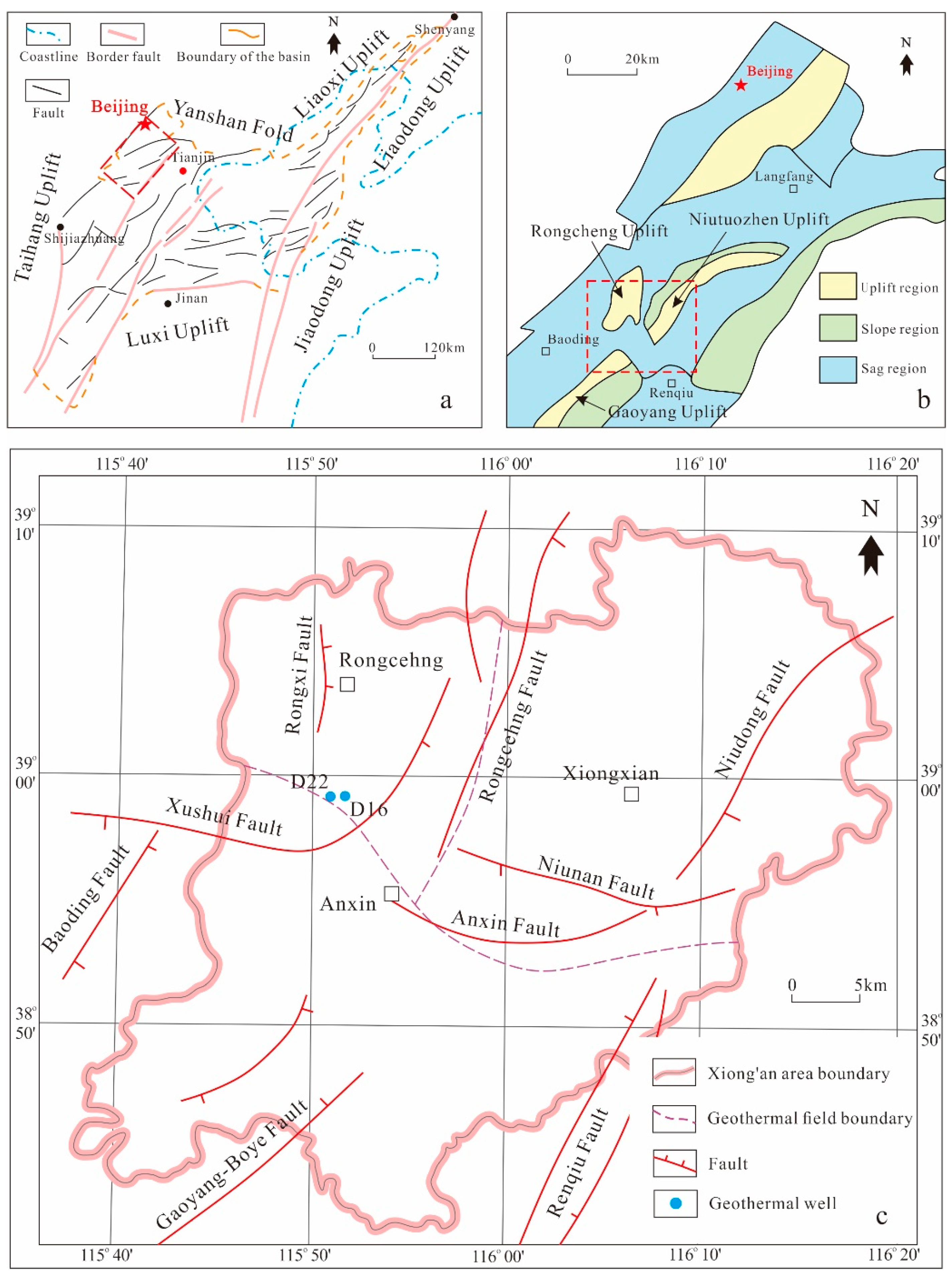

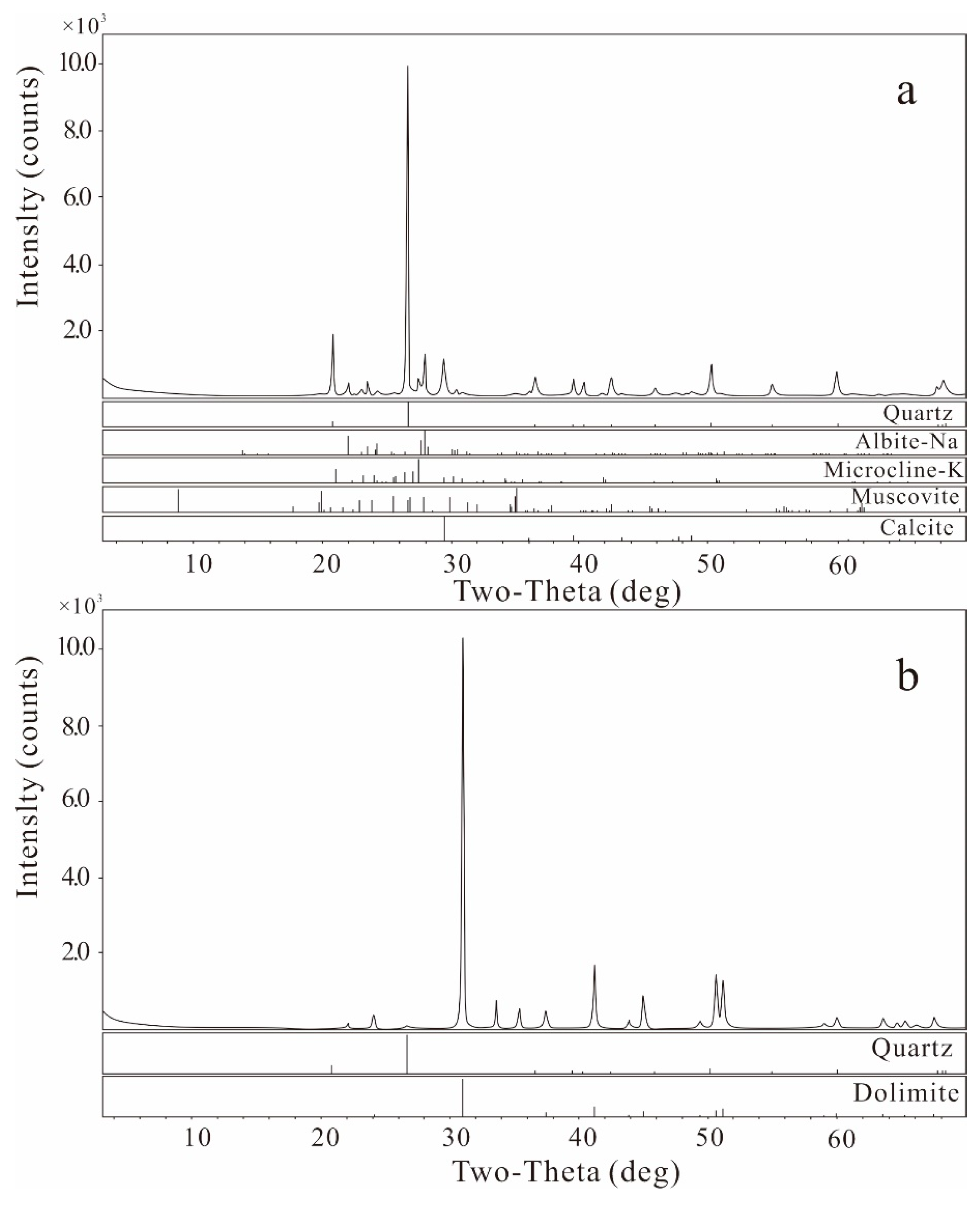
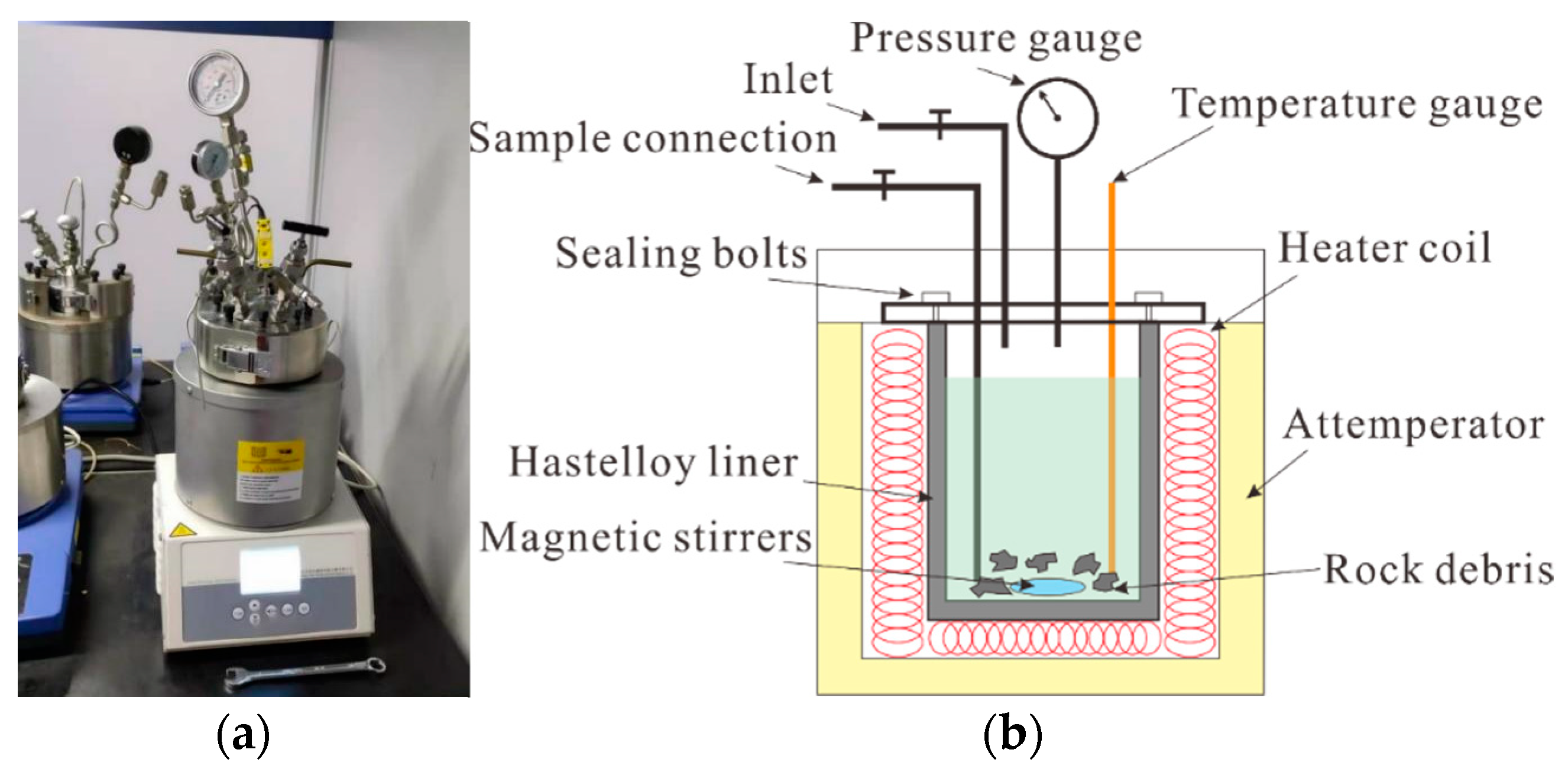
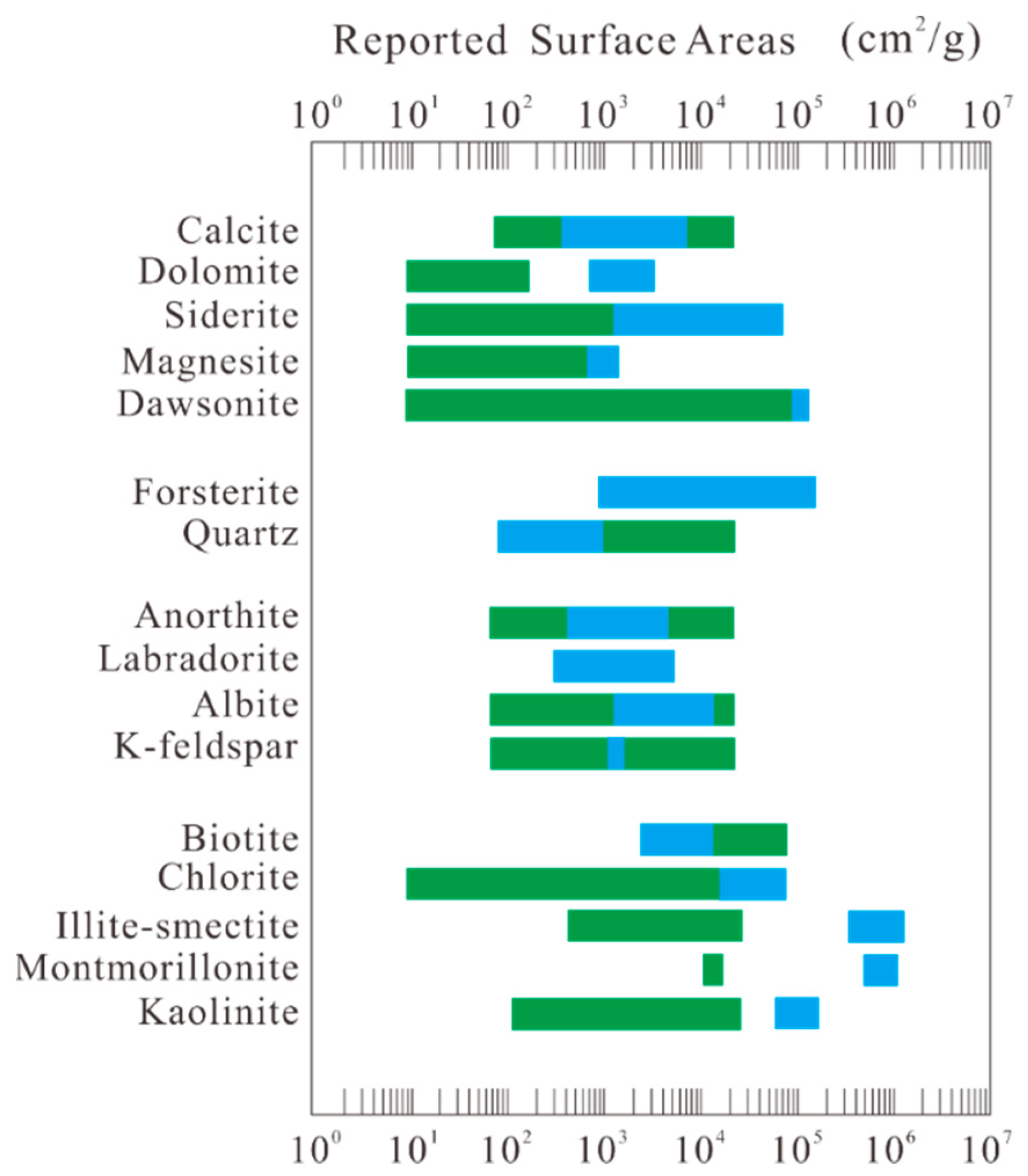
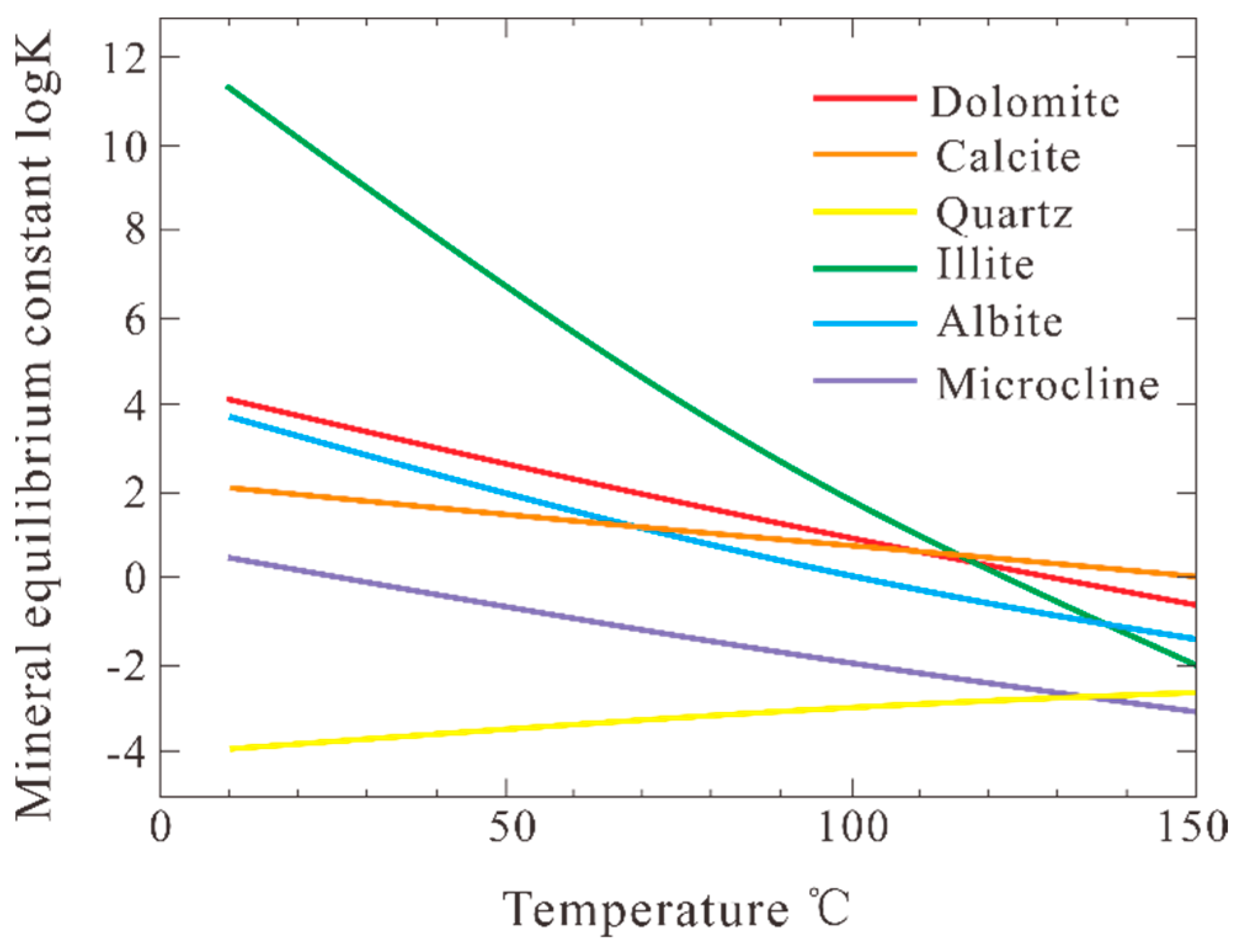

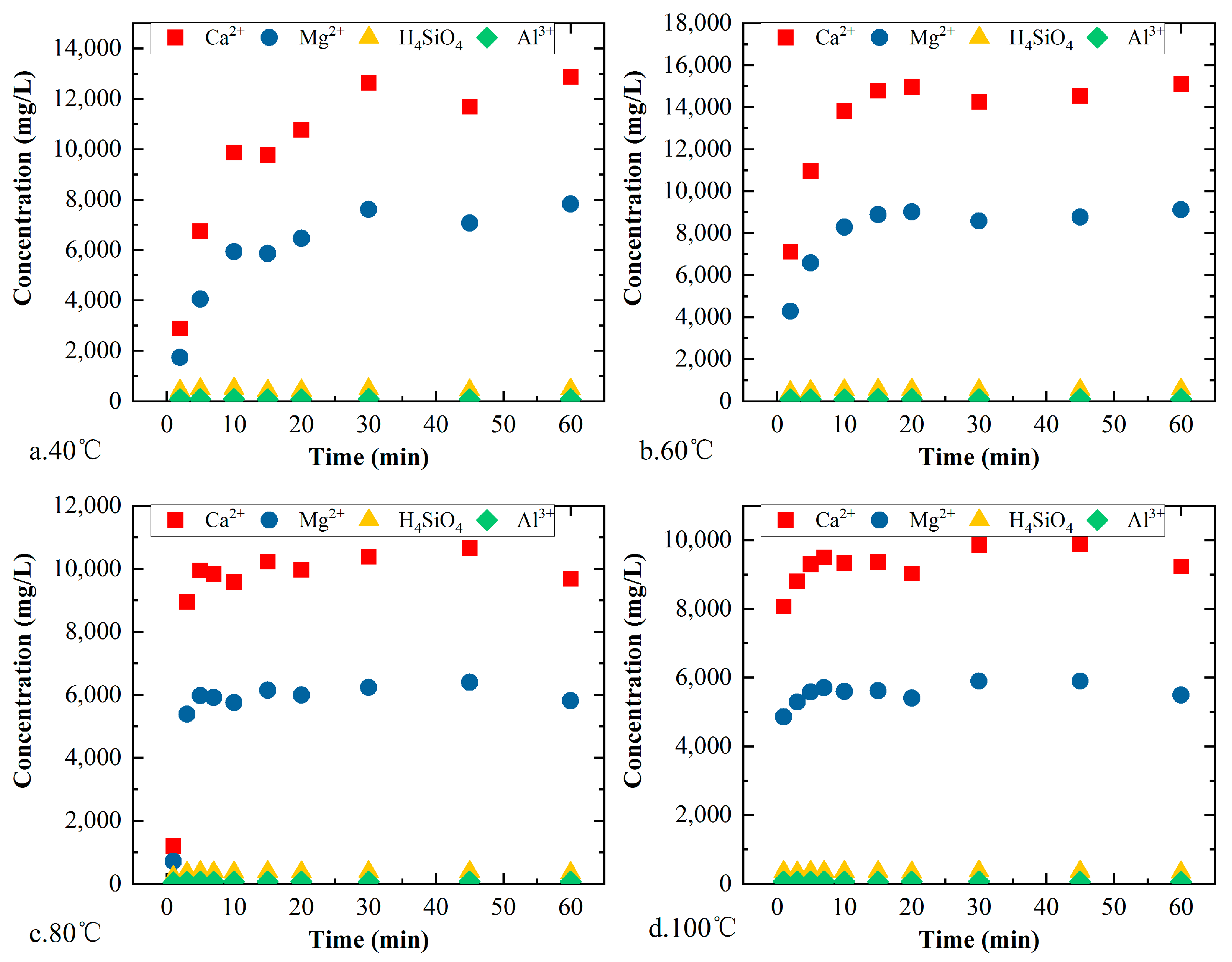
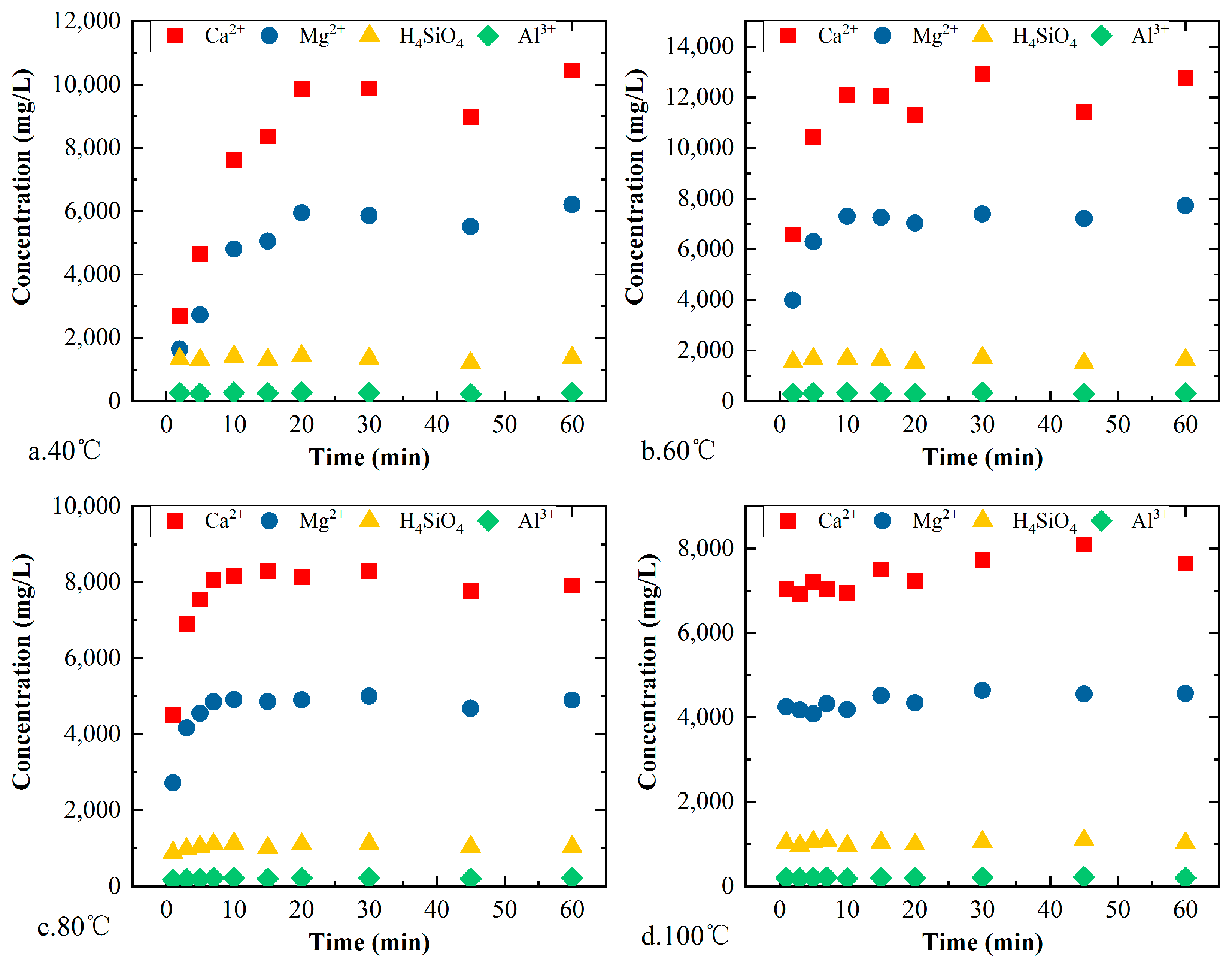
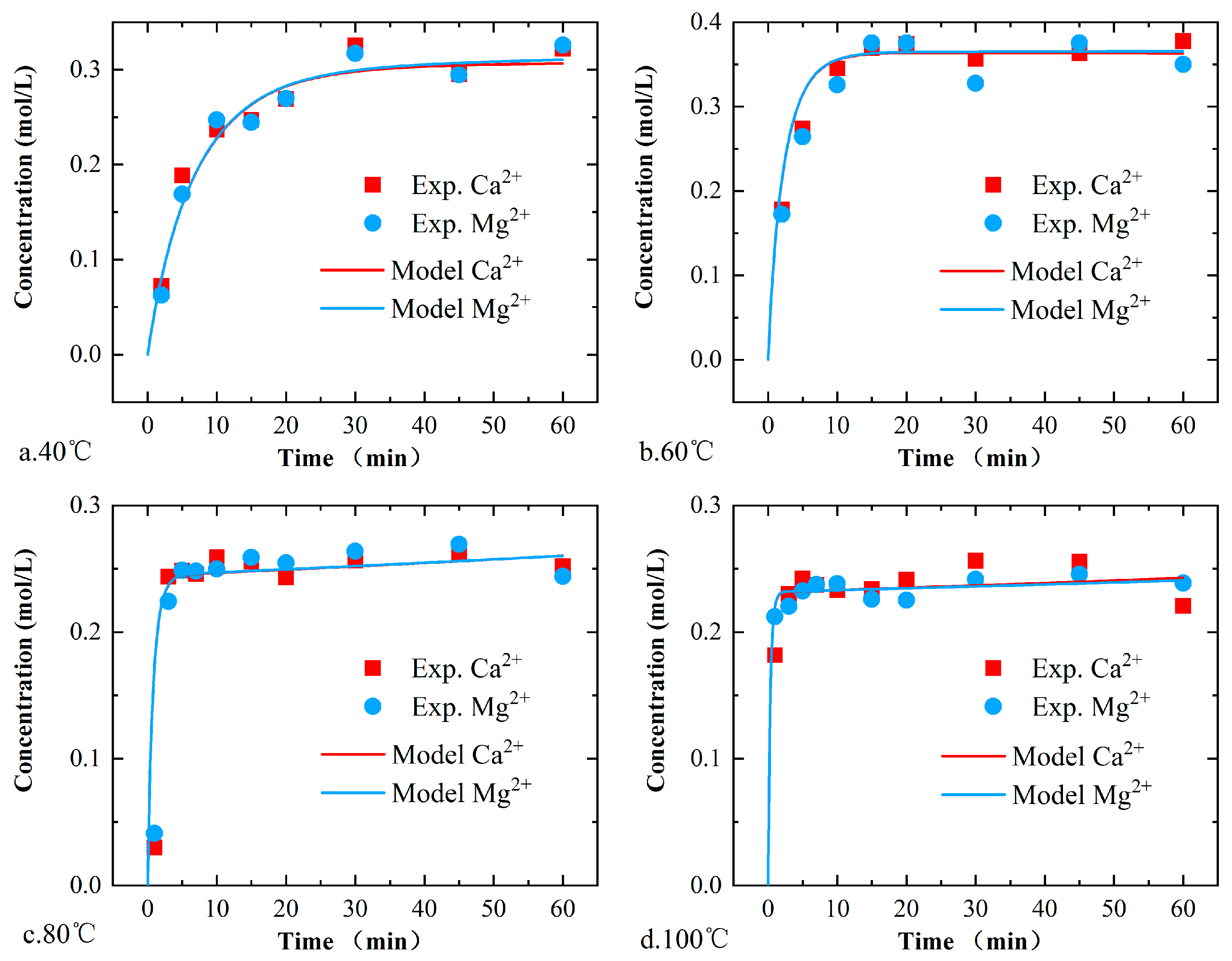
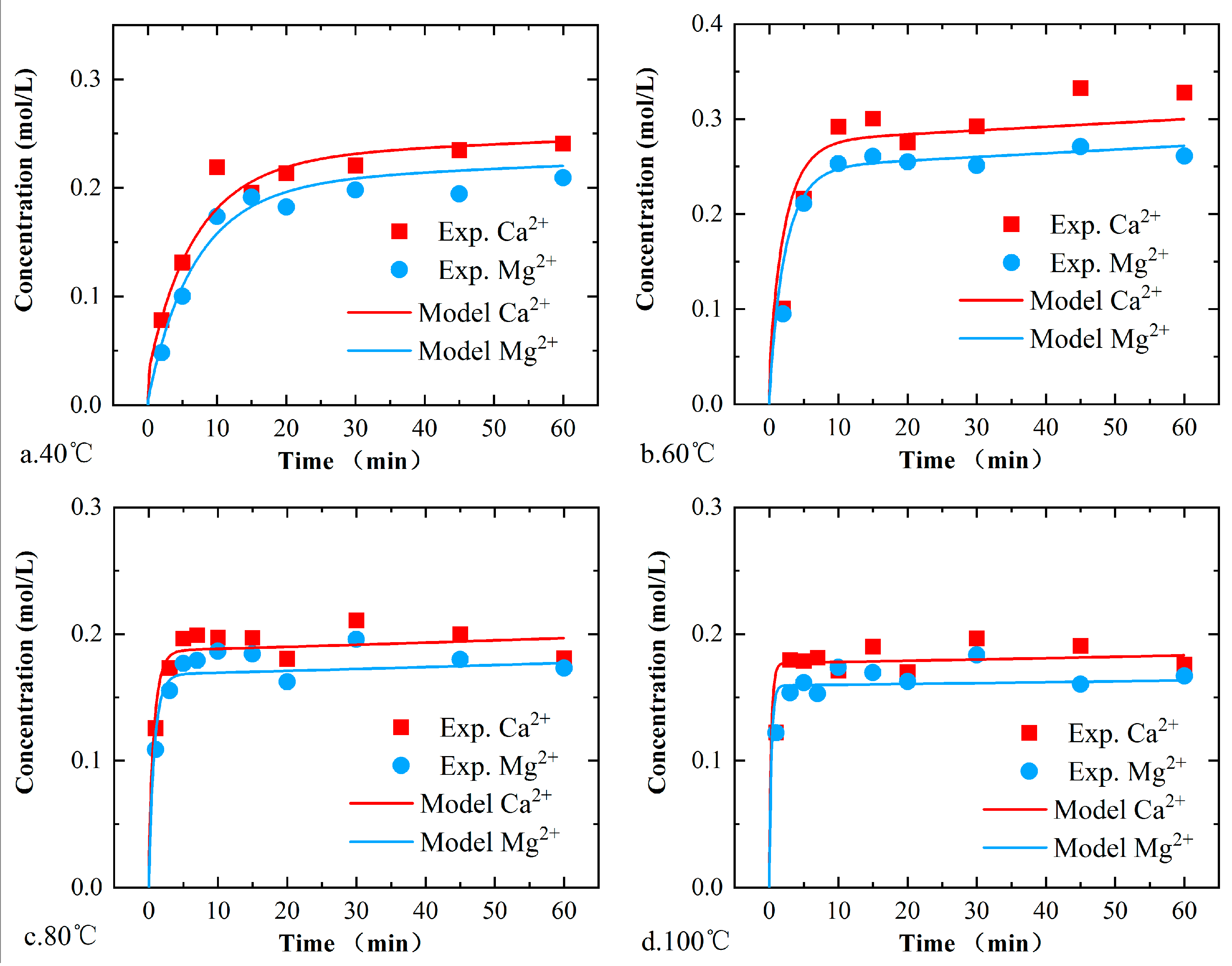

| Serial Number | Lithological Name | Main Components | Picture |
|---|---|---|---|
| 1 | Silty dolomite | Dolomite (>99%): semi-autohedral rhombohedrons arranged in a mosaic shape, form the main body of the rock. The fractures are filled by late carbonate minerals, which are also found in the rock. | 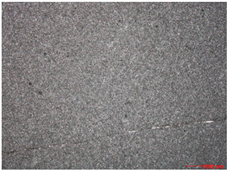 |
| 2 | Laminated siliceous silty dolomite | It is composed of dolomite (45%) and siliceous material (55%), and the two components are alternately distributed in strips and stripes, forming horizontal to microwave laminations with different widths, i.e., a lamination structure. The laminae are sometimes interspersed with each other. | 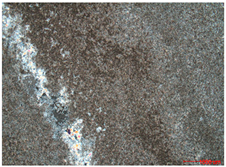 |
| 3 | Argillaceous silty micrite dolomite | Dolomite (75–80%): it is mainly allomorphic granular, and the aggregates are distributed in strips and laminations. It is the main body of the rock. Clayey soil (15–20%): it is composed of cryptocrystalline micro-scale clayey minerals, which are enriched and distributed in strips. There are cracks filled with dolomite and gypsum in the rock. | 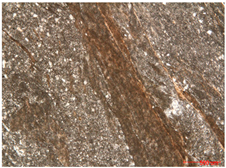 |
| 4 | Clayey sandy argillaceous dolomite | The dolomite (40%) is hemihedral rhombohedral allomorphic granular in form; Calcite (20%): it is hemihedral rhombohedron—allomorphic granular, with limonitization in the later stage. Terrigenous sand debris (25%): it is composed of quartz, potassium feldspar and plagioclase. The type of potassium feldspar is microcline, with kaolinization and limonitization in the later stage. Clayey soil (15%). |  |
| Sample Number | Sample Depth | Dolomite (%) | Quartz (%) | Clay (%) | K-Feldspar (%) | Plagioclase (%) | Calcite (%) |
|---|---|---|---|---|---|---|---|
| R1 | 2904–2906 | 70 | 5 | 10 | 5 | 5 | 5 |
| R2 | 3048–3050 | 99 | 0 | 0 | 0 | ||
| R3 | 3050–3052 | 80 | 14 | 5 | 1 | ||
| R4 | 3108–3110 | 75 | 15 | 6 | 1 |
| Serial Number | Core Number | Reaction Temperature °C |
|---|---|---|
| S01 | R1 | 40 |
| S02 | 60 | |
| S03 | 80 | |
| S04 | 100 | |
| S05 | R2 | 40 |
| S06 | 60 | |
| S07 | 80 | |
| S08 | 100 | |
| S09 | R3 | 40 |
| S10 | 60 | |
| S11 | 80 | |
| S12 | 100 |
| Coefficients | Dolomite | Calcite | Quartz | Illite | Albite | Microcline |
|---|---|---|---|---|---|---|
| a | 2.83 × 102 | 1.34 × 102 | 5.39 × 101 | 3.81 × 102 | 2.55 × 102 | 2.46 × 102 |
| b | −1.79 × 103 | −8.50 × 102 | −3.54 × 102 | −2.48 × 103 | −1.66 × 103 | −1.60 × 103 |
| c | −2.90 × 10−1 | −1.39 × 10−1 | −4.19 × 10−2 | −3.44 × 10−1 | −2.20 × 10−1 | −2.13 × 10−1 |
| d | 9.96 × 104 | 4.69 × 104 | 2.18 × 104 | 1.55 × 105 | 1.04 × 105 | 9.92 × 104 |
| e | −5.60 × 106 | −2.66 × 106 | −1.59 × 106 | −9.06 × 106 | −6.44 × 106 | −6.29 × 106 |
| Minerals | Neutral Reaction Mechanism | |
|---|---|---|
|
Reaction Activation Energy Ea kJ/mol | ||
| Dolomite | 1.1 × 10−8 | 31 |
| Quartz | 6.4 × 10−14 | 77 |
| Calcite | 1.6 × 10−6 | 24 |
| Illite | 3.3 × 10−17 | 35 |
| Albite | 5.1 × 10−20 | 57 |
| Microcline | 1.0 × 10−14 | 31 |
| Sample Depth | Reaction Temperature (°C) | Reaction Time min | 15 wt.% HCl Dissolution Ratio (%) | 20 wt.% HCl Dissolution Ratio (%) |
|---|---|---|---|---|
| 3158–3160 m | 60 | 60 | 78.1 | 82.3 |
| 3174–3176 m | 60 | 60 | 87.3 | 88.5 |
| 3178–3180 m | 60 | 60 | 86.9 | 87.2 |
| Minerals | Acid Reaction Mechanism | |
|---|---|---|
|
Reaction Activation Energy Ea kJ/mol | ||
| Dolomite | 2.4 × 10−4 | 46 |
| Calcite | 5.3 × 10−1 | 14 |
| Illite | 9.5 × 10−2 | 36 |
Publisher’s Note: MDPI stays neutral with regard to jurisdictional claims in published maps and institutional affiliations. |
© 2022 by the authors. Licensee MDPI, Basel, Switzerland. This article is an open access article distributed under the terms and conditions of the Creative Commons Attribution (CC BY) license (https://creativecommons.org/licenses/by/4.0/).
Share and Cite
Yue, G.; Zhu, X.; Wang, G.; Ma, F. Mineral Reaction Kinetics during Aciding of the Gaoyuzhuang Carbonate Geothermal Reservoir in the Xiong’an New Area, Northern China. Water 2022, 14, 3160. https://doi.org/10.3390/w14193160
Yue G, Zhu X, Wang G, Ma F. Mineral Reaction Kinetics during Aciding of the Gaoyuzhuang Carbonate Geothermal Reservoir in the Xiong’an New Area, Northern China. Water. 2022; 14(19):3160. https://doi.org/10.3390/w14193160
Chicago/Turabian StyleYue, Gaofan, Xi Zhu, Guiling Wang, and Feng Ma. 2022. "Mineral Reaction Kinetics during Aciding of the Gaoyuzhuang Carbonate Geothermal Reservoir in the Xiong’an New Area, Northern China" Water 14, no. 19: 3160. https://doi.org/10.3390/w14193160
APA StyleYue, G., Zhu, X., Wang, G., & Ma, F. (2022). Mineral Reaction Kinetics during Aciding of the Gaoyuzhuang Carbonate Geothermal Reservoir in the Xiong’an New Area, Northern China. Water, 14(19), 3160. https://doi.org/10.3390/w14193160







